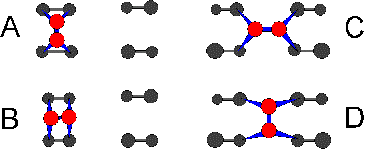 |
 |
Despite rapid advances in the study of epitaxial growth on semiconductor surfaces, several processes of fundamental importance are still not understood in detail. Among these are island nucleation and growth. With the advent of scanning tunneling microscopy and the development of new theoretical methods, it has been possible to study these processes in a new depth of detail. A more realistic picture of island formation starting from one atom and going to two atoms, three atoms, and so on reveals that in these beginning stages, the structures which form may bear little resemblance to the epitaxial island that is eventually produced. In this way, the complexity of the competition between what is energetically favorable and what is kinetically likely is more fully appreciated.
Here, we focus on the smallest island that has rebonded step edges on both ends, as is characteristic of epitaxial rows. This island consists of three dimers, one on top of a dimer row and one in each of the two adjacent trough sites. Once growth has proceeded through the first six atoms to form this type of an island, the island can then serve as a seed for further growth by the addition of four atom units at either end. However, it is unlikely for three dimers (or six atoms) to meet and spontaneously form such an island. On this page we will discuss a mechanism for the formation of six-atom epitaxial islands (with rebonded ends) that we have observed in hot STM movies of annealing on the Si(001) surface near 420 K. It starts with a four-atom segment of dilute dimer row, called a "cross structure."1 The cross structure is observed to convert to a little-known four-atom structure, which we call a "tie structure." The tie structure is then observed to grow to a six-atom island, with the addition of two atoms. Thus, the metastable cross and tie structures may play an important role in the nucleation of epitaxial islands on Si(001).

FIG. 1. Schematic drawings of the configurations of isolated adsorbed dimers on Si(001)., Black circles represent substrate atoms. Red circles represent adatoms on the surface. Lines are drawn to indicate the electronic bonds. Segments of four substrate dimer rows are shown in the figure, running vertically.
Experimental and theoretical evidence suggests that there are four principal ad-dimer configurations on Si(001)1,2,3,4,5. As shown in Fig. 1, a dimer can sit on top of a dimer row (A and B) or in the trough between two rows (C and D), with its axis oriented either parallel or perpendicular to the dimer row direction. These single dimer configurations are important in describing and understanding the structures involved in epitaxial island formation. Configuration A is lowest in energy and is in epitaxial orientation. Configuration C easily captures an additional atom on either side, forming a three-atom structure or the four-atom cross structure.
Figure 2 shows filled and empty state images of the structures important in the observed epitaxial island formation process. Figures 2(a) and 2(b) show the four-atom cross structure.1,3 This structure is centered on the trough between two dimer rows of the surface. The central two atoms are in dimer configuration C, which is rotated 90 degrees from the epitaxial orientation. Figures 2(c) and 2(d) show another four-atom structure, one which is not well documented. However, it plays a key role in our observed island formation process, as described below. This structure is centered on the top of a dimer row, and we have called it the "tie structure". The atomic arrangement of the four atoms, as shown in the ball and stick model, is a proposed arrangement that seems reasonable due to the appearance of the structure. In this arrangement, the central two atoms are in dimer configuration A, which is the lowest energy dimer configuration. Likewise, in the cross structure, the central two atoms are in configuration C, which is the lower energy configuration for dimers in the trough.
The formation of a six-atom epitaxial island is shown in Fig. 3. These images are consecutive and come from an STM movie of annealing at 420 K that was obtained after deposition of about 0.05 ML. The images were taken at 1 minute intervals. We observe conversions between the cross and tie structures, and find that occasionally a six-atom island is formed by the addition of two atoms to the tie structure. (The two additional atoms could presumably have arrived separately as monomers, or as a single dimer. In one case, we have seen a dimer diffuse along the top of a dimer row and then interact with a tie structure to form a six-atom island.) The six-atom island formed by this process has rebonded step edges on both ends, which is energetically favorable. Thus the tie structure appears to be an important intermediate state on the way to epitaxial island formation.
The conversion from a cross to a tie can be compared to the diffusion of a dimer across dimer rows. The dimer in the center of the cross structure is in dimer configuration C, located in a trough. As the cross converts to a tie, the dimer moves into configuration A, located on top of a row. Likewise, it has recently been shown that in crossing dimer rows (which occurs at temperatures near 450 K), a dimer moves from A to C to A.6 Thus, it is intriguing that conversion from a cross to a tie involves a motion of the central dimer which is similar to dimer diffusion across dimer rows.
We have studied the growth of epitaxial Si islands on Si(001) through the first six atoms, which results in an energetically favorable island with rebonded type B step edges on both ends. For the nucleation mechanism observed, the key element is the conversion from the cross structure to the tie structure. Future work must determine whether or not, under realistic deposition conditions, this is the dominant nucleation mechanism for epitaxial islands over some range of temperatures.
2T. Yamasaki, T. Uda and K. Terakura, Phys. Rev. Lett. 76, 2949 (1996).
3G. Brocks and P. J. Kelly, Phys. Rev. Lett. 76, 2362 (1996).
4P. J. Bedrossian, Phys. Rev. Lett. 74, 3648 (1995).
5Z. Zhang, F. Wu, H. J. W. Zandvliet, B. Poelsema, H. Metiu, and M. G. Lagally, Phys. Rev. Lett. 74, 3644 (1995).
6Brian Borovsky, Michael Krueger, and Eric Ganz, Phys. Rev. Lett. 22, 4229 (1997).